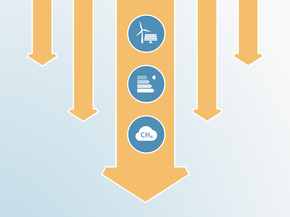Country summary
Overview
The Trump Administration is pursuing an executive and legislative agenda to systematically repeal targets, policies, and funding for climate change mitigation and science. The administration is actively obstructing the buildout of renewable energy, while encouraging the production and consumption of fossil fuels, completely reversing the Biden Administration’s course on climate action. This is the most aggressive, comprehensive, and consequential climate policy rollback that the Climate Action Tracker has ever analysed.
The Trump Administration withdrew the US from the Paris Agreement, annulling the Biden Administration’s emissions reductions targets for 2030, 2035, and 2050. The One Big Beautiful Bill Act (OBBB) undermines progress in deploying renewable energy and clean energy technologies that was accelerated by the Inflation Reduction Act (IRA).
Under the Trump Administration’s direction, the US Environmental Protection Agency (EPA) has moved to revoke key emissions regulations in the power and transport sectors, as well as the agency’s legal authority to regulate greenhouse gas emissions across all economic sectors. At the same time, the Trump Administration has invoked emergency powers to rapidly expand oil and gas drilling across the country.
In combination, the Trump Administration’s policies and actions will significantly slow—but not stop—emission reductions in the US. As a result, the US will be even further off track from aligning its emissions with a 1.5°C trajectory.
The CAT rates US climate targets, action, and climate finance as “Critically Insufficient.”
The CAT’s current policies scenario projections, which consider the enactment of OBBB and pending changes to emission standards in the power and transport sectors, show a substantial deceleration in emission reductions compared with the CAT’s previous projections. While still decreasing, emissions are projected to be approximately 600MtCO2e–800MtCO2e higher in 2030 under the Trump Administration’s policies and actions compared to emissions projections under the Biden Administration.
Under the Trump Administration, US emissions will decrease by 19%–30% in 2030 below 2005 levels, excluding emissions from land use change and forestry (LULUCF), while the Biden Administration was on track to reduce emissions by 29%–39% in 2030 below 2005 levels (excl. LULUCF).
The Trump Administration’s agenda fundamentally obstructs progress towards reducing emissions in the US and seriously threatens global efforts towards phasing out fossil fuels:
- Oil and gas production is set to increase. The Trump Administration is using emergency powers to rapidly expand oil and gas drilling on federal lands and waters, even as the US is already the world’s largest producer of crude oil and fossil gas. Continued investments in new fossil fuel supply are entirely incompatible with reaching net zero emissions by 2050.
- The Trump Administration is exploiting US economic leverage to hinder climate action abroad. The administration rescinded much of the US’ climate and development finance commitments, while seeking to limit climate finance flows from multilateral organisations. In parallel, the administration is pressuring trading partners to purchase more US-made LNG.
- The deployment of wind and solar will slow substantially as more fossil-gas power capacity is added. The OBBB terminates federal tax incentives for wind and solar power generation, which were expanded by the IRA and were driving growth in renewables. At the same time, the US plans to develop more new fossil gas-fired power plants than any other country, locking in substantial additional emissions from the power sector over the coming decades; especially given that the EPA seeks to repeal all emissions regulations for existing and new fossil fuel-fired power plants. The Trump Administration’s efforts to revive coal-fired power generation stand in direct opposition to the market’s steady phase-out of coal.
- Federal incentives for electric vehicles (EVs) are phased out, while the regulatory framework for vehicle emissions is weakened. The OBBB terminates key tax credits for EVs, which will significantly decrease EV sales. In doing so, the OBBB undermines automaker investments in the domestic EV value chain that were spurred by the IRA’s passage. The EPA and US Department of Transportation (DOT) initiated the repeal of emissions and efficiency regulations for new vehicles. Together, these legislative and executive actions will prolong the production of internal combustion engine (ICE) vehicles, hampering emissions reductions from transport.
- The OBBB incentivises energy and emissions-intensive industry in the US and abroad. The OBBB distorts IRA tax credits to encourage the production of coal that is exported for steelmaking.
- Measures for improving efficiency and increasing electrification in the buildings sector are terminated. Decarbonising the buildings sector will heavily rely on electrification. However, the OBBB eliminated critical incentives for electrifying buildings. The Trump Administration also rescinded federal funding for building code implementation, decreasing building efficiency and increasing consumer costs.
- Federal efforts to reduce emissions from agriculture were insufficient under the Biden Administration and the Trump Administration has further weakened the federal government’s policy package for mitigating agricultural emissions.
- Net forest sinks are threatened by land conversion, an increased demand for timber products, and a higher frequency of natural disturbances from climate change. The Trump Administration is massively expanding timber production on federal lands. Even under the Biden Administration, which increased funding for carbon sink preservation, logging efforts were increasing.
To offset the Trump Administration’s policy rollbacks, subnational actors continue to implement ambitious emissions reductions measures:
- States are and will continue to advance the Biden Administration’s progress on climate action. The 2035 NDC target, submitted by the Biden Administration in 2024, was developed in close consultation with state governments and can still guide state action on mitigating emissions. The US Climate Alliance—a bipartisan coalition of 24 states and territories—remains committed to advancing climate action. However, the Trump Administration is pursuing legal action to inhibit state-level decarbonisation measures.
Description of CAT ratings
The CAT rates each country’s targets and policies against (1) its fair share contribution to climate change mitigation considering a range of equity principles including responsibility, capability, and equality, and (2) what is technically and economically feasible using modelled domestic pathways which, in absence of a better method, are based on global least-cost climate change mitigation.
Comparing a country’s fair share ranges and modelled domestic pathways provides insights into which governments should provide climate finance and which should receive it. Developed countries with large responsibility for historical emissions and high per-capita emissions, must not only implement ambitious climate action domestically but must also support climate action in developing countries with lower historical responsibility, capability, and lower per-capita emissions.
The CAT rates the combination of the US targets, policies, and climate finance as “Critically Insufficient.” The “Critically Insufficient” rating indicates that the US’ climate policies and commitments reflect minimal to no action and are not at all consistent with the Paris Agreement’s 1.5°C temperature limit.
The Trump Administration’s withdrawal from the Paris Agreement nullifies the US’ domestic emissions reduction targets (NDCs) for 2030 and 2035. The administration has rescinded most of the US’ international climate finance commitments, which were already critically insufficient under the Biden Administration.
The CAT rates the US’ policies and action as “Highly Insufficient.” The rating indicates that the government’s climate policies and action are not consistent with the Paris Agreement’s 1.5°C temperature limit. The CAT projects US GHG emissions in 2030 will be 19%–30% below 2005 levels (excl. LULUCF). For reference, under the Biden Administration’s policies and actions, the CAT projected GHG emissions in 2030 would have been 29%–39% below 2005 levels (excl. LULUCF). Under both administrations, current policies fall significantly short of the US fair share target.
In July 2025, President Tump signed the One Big Beautiful Bill Act (OBBB) into law. The OBBB dismantles much of the Inflation Reduction Act’s (IRA) efforts to reduce emissions in the power, transport, industry, and buildings sectors. The Trump Administration is considering overturning emissions standards in the power and transport sectors; both of which were strengthened by the Biden Administration in 2024.
The CAT presents a broad emissions projections range through 2035 that is derived from literature, as well as an independent quantification of current policies and actions that falls within the literature-derived range. The independently quantified projection underpins the CAT’s overall rating of the US policies and actions, while the literature-derived range in emissions projections showcases the uncertainty associated with many of the Trump Administration’s policy changes, especially those policy changes that directly clash with market forces that are driving out coal and scaling up renewables.
See full summary of policies and actions here.
The CAT rates the US’ lack of NDC targets as ”Critically Insufficient” against modelled domestic pathways. The Trump Administration voided the US existing 2030 and 2035 NDC targets, established by the Biden Administration in 2021 and 2024, respectively. The ”Critically Insufficient” rating indicates the Trump Administration’s revocation of the NDC targets is not at all consistent with limiting warming to 1.5°C. If all countries were to follow a US approach, warming would exceed 4°C.
The CAT rates the lack of NDC targets as ”Critically Insufficient” against fair share. The Trump Administration annulled the existing US NDC targets for 2030 and 2035. The “Critically Insufficient” rating indicates the Trump Administration’s revocation of the NDC targets is not at all consistent with limiting warming to 1.5°C. If all countries were to follow the US approach, warming would exceed 4°C.
We rate the United States’ international public climate finance contributions as “Critically Insufficient.” This rating is based on the government’s 2025 OECD contributions. The Trump Administration dismantled the US international aid apparatus and rescinded climate finance commitments.
Even under the Biden Administration, the CAT rated the US international public climate finance contributions as “Critically Insufficient.” To improve its rating, the US needs to ramp up the level of its international climate finance contributions and stop supporting fossil fuels abroad.
The US’ climate finance is not sufficient to improve the rating of its NDC against its fair share, and the CAT rates the US’s overall fair share contribution as “Critically insufficient.”
The Trump Administration is not committed to reaching net zero emissions. Therefore, the CAT considers the US to no longer have a net zero target. Although the federal government does not have a net zero target, 19 states are still pursuing net zero (Net Zero Tracker, 2025).
Further analysis
Latest publications
Stay informed
Subscribe to our newsletter




